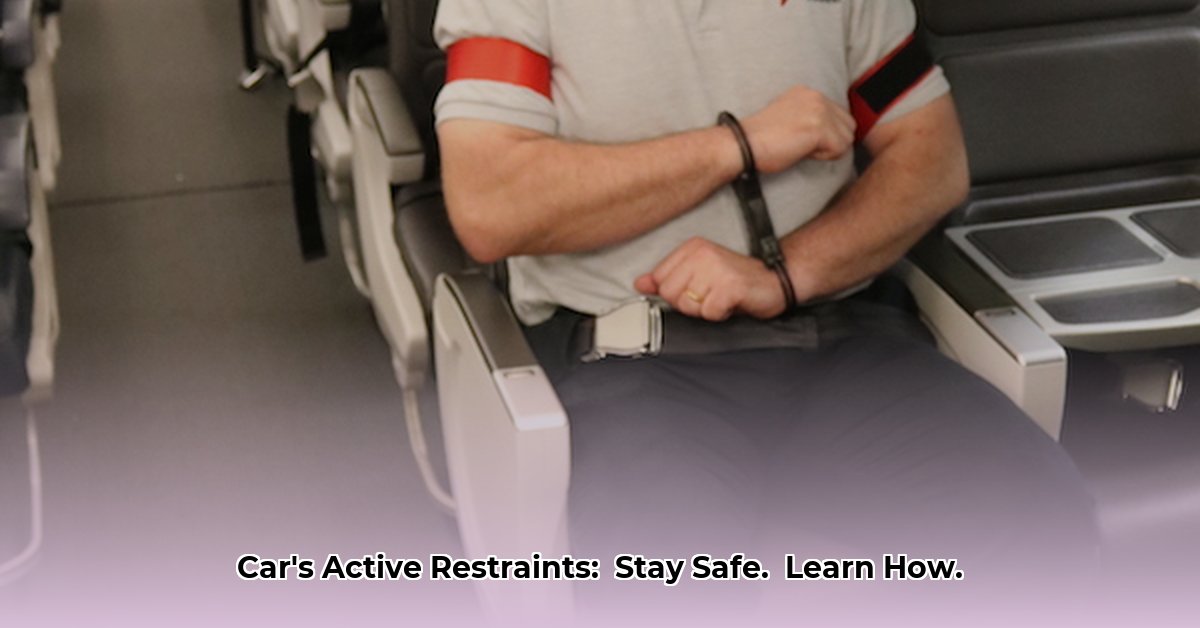Understanding Active Safety: Beyond the Airbag
Car safety isn’t just about airbags and crumple zones. It’s also about the features that work before a crash, minimizing the impact or even preventing the accident altogether: active restraints. Unlike passive restraints that automatically deploy during a collision, active restraints require some level of interaction, either from you or triggered by the car itself. Think of them as your partners in safety, actively working to keep you safe.
Seatbelts: The First Line of Defense
Seatbelts are perhaps the most recognizable and crucial active restraint. Buckling up is a simple action with potentially life-saving consequences. Seatbelts prevent ejection during a crash and distribute the force of impact across stronger body parts like the chest and pelvis, minimizing stress on vulnerable areas. They’re designed to work in conjunction with pretensioners, devices that automatically tighten the seatbelt during a crash, removing slack and securing you firmly against your seat.
Head Restraints: Protecting Your Neck
Properly adjusted head restraints are crucial, especially in rear-end collisions, a common cause of whiplash. They limit the backward movement of your head, reducing strain on your neck and spine. Some modern vehicles feature active head restraints that automatically adjust during a collision, providing an extra layer of protection. For optimal protection, the top of the head restraint should be level with the top of your head.
Child Safety Seats: Protecting the Most Vulnerable
Children require specialized protection due to their developing bodies. Child safety seats are active restraints designed to provide a secure environment during a crash. Choosing the right seat based on a child’s age, height, and weight is essential. Proper installation is equally critical—a poorly installed car seat can compromise its effectiveness.
Installing a Child Safety Seat: A Step-by-Step Guide
- Choose the Right Seat: Select the appropriate type (infant, convertible, booster) based on your child’s age, weight, and height. Consult the manufacturer’s guidelines.
- Consult the Manuals: Refer to both the car seat and vehicle owner’s manuals for specific instructions.
- Secure the Base: Use either the LATCH system or the vehicle’s seatbelt, ensuring a tight fit. The seat should not move more than an inch in any direction at the belt path.
- Harness Your Child: Secure the harness straps snugly across the shoulders and hips. You should be able to fit two fingers between the straps and your child’s collarbone.
Find a Certified Child Passenger Safety Technician Near You
Active vs. Passive Restraints: A Collaborative Approach
Active and passive restraints work together to create a comprehensive safety system:
| Feature | Active Restraints | Passive Restraints |
|---|---|---|
| Requires Action | Yes (driver or system) | No |
| Purpose | Prevents or minimizes impact | Lessens impact after collision |
| Examples | Seatbelts, Child Seats, Head Restraints | Airbags, Crumple Zones |
The Blurring Lines of Automotive Safety
The line between active and passive systems is blurring with features like automatic emergency braking (AEB) and lane keeping assist. These systems actively work to prevent collisions but can also intervene during a crash. Such advancements suggest that active safety technologies may eventually play an even greater role in vehicle safety.
FAQs: Addressing Your Concerns
- Are advanced safety systems expensive? While they can add to a vehicle’s cost, many new cars include some active safety features as standard equipment. Additionally, some insurance companies offer discounts for vehicles equipped with these features.
- Do active restraint systems require maintenance? Consult your owner’s manual for recommended maintenance schedules. Some systems might need occasional checks or calibration.
The Future of Active Safety
Ongoing research and development continually improve automotive safety. While the future likely holds even more sophisticated systems, today’s active restraints remain critical. By understanding how these systems work and using them correctly, you can significantly enhance your safety on the road. Stay informed about the latest advancements, and remember that technology assists, but doesn’t replace, attentive driving. For more information on car safety, visit the National Highway Traffic Safety Administration (NHTSA) website.
- How Did Charles F. Brush Discover Wind Energy Tech? - November 19, 2025
- Wind Energy Vertical: Weighing the Pros and Cons of Wind Power - November 16, 2025
- How Much Energy Does a Wind Turbine Actually Create? - November 14, 2025
















